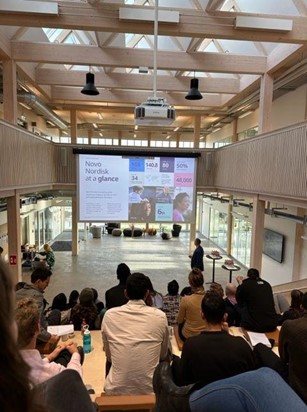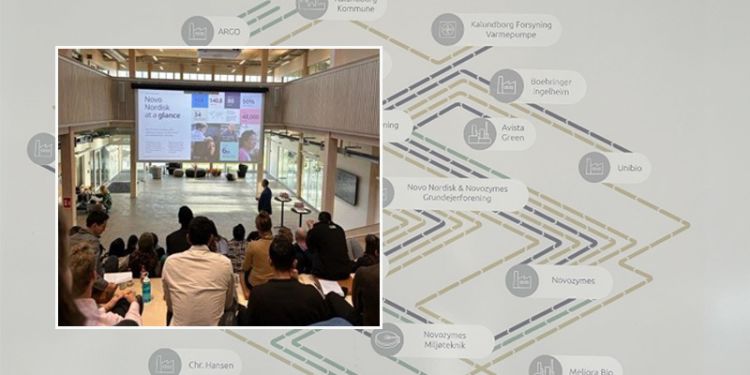In January 2023, Professors Willy Shih and Mike Toffel led more than 40 HBS MBA students on site visits to witness the energy transition and innovative sustainable production activities throughout Denmark and the Netherlands, in their new Immersive Field Course (IFC). This is one of 13 student essays posted on the HBS Business and Environment Initiative’s Blog that highlights their reflections. Learn more about this IFC course on Decarbonization and Sustainable Production by watching this five minute video summary.
Visit Date: January 6, 2023
We started the day early for our visit to the Novo Nordisk facilities in Kalundborg, Denmark, with a sunrise ferry from Aarhus, midway through our ten-day whirlwind trip through Denmark and the Netherlands. By then, we had been introduced to decarbonization and sustainability efforts across several energy and consumer products firms. Suiting up for a contamination-free walk at the world’s largest insulin production site that employees 3,500 people, we were excited to observe them produce half of the world’s supply of insulin.
Our visit was led by one of the company’s engineers, who began our tour by picking up several vials from a display cabinet and asking us to guess how many lives a tiny one-inch vial of muddy yeast cultures could save. Have a guess? It turned out that with roughly half the yeast you might use to bake a loaf of bread (modified, of course), you can save half a million lives! The anticipation grew from there, as we learned details of how Novo Nordisk manufactures within its 1,200,000 square meter facility high-quality active pharmaceutical ingredients (APIs) that tackle not only diabetes but also hemophilia, growth disorders, and obesity.
At their Kalundborg site, Novo Nordisk has optimized a three-stage process to produce human insulin in genetically modified yeast cells: fermentation, recovery, and purification. The company also handles manufacturing and supply chain development, upscaling for production, assembly of delivery devices, packing of product, and cold chain transportation of final products. This highly complex in-house integrated process is the hallmark and competitive advantage of their 50-year history of innovation and drive for excellence.

Sustainability Challenges
One of the largest problems the company currently faces with its circular sustainability approach is how to handle the end of life recyclability and reusability of their injection devices. While researching Novo Nordisk before our visit, one of the solutions that looked promising to us was the development of their novel oral insulin delivery system used to treat patients with Type II diabetes (not all of insulin’s use cases). It currently needs 100-175x the amount of active pharmaceutical ingredient (API) compared to insulin injection pens because the oral drug is absorbed via the stomach lining, with a relatively low bioavailability.
When asked if Novo Nordisk thinks there could be developments to advance NovoNorm to a point of overtaking all direct injection delivery methods to eliminate the syringes that become waste after being used, our site host responded that the technology required is too far in the future to consider that a realistic solution. Instead, they are currently focusing on a project replacing the current plastic materials used in the injection devices (e.g., the injection pen casing) with bioplastic to allow the injection devices to be more biodegradable. In the near term, this might prove a much more realistic solution to the sustainability challenges of one-time use injection devices.
Local Collaboration
Another topic we looked forward to learning more about during our visit was Novo Nordisk’s use of symbiosis—sharing waste and energy streams—with nearby companies to improve sustainability. Our research had not captured how important symbiosis has become for the entire Kalundborg region—businesses and households alike. Symbiosis is a real-life example of “one man's trash is another man's treasure.”
To learn about this process, we visited the Helix Lab in Kalundborg, which is a knowledge center connecting Danish universities with local businesses. There, we learned that the first partnerships in the region for sharing waste and energy were opportunistic business deals. Anchor companies such as Novo Nordisk and Novozymes came together in the early 1960s to form a board of directors and thematic working groups that shared information, drove partnerships, and facilitated investment across businesses and the municipality. These contracts were not branded as “sustainability” initiatives – they were just viewed as great business opportunities. In fact, it wasn’t until 1989, when local high schoolers did a project on the topic and named the relationships Industrial Symbiosis, that they really noted just how unusual this resource ecosystem was.

At Kalundborg, resources such as water, energy, and materials are circulated between local businesses and the municipality. For instance, Novo Nordisk can take excess heat, a byproduct of fermentation, and use it to heat up water. This water can be piped to the local municipality to heat houses through district heating. In addition, sludge from fermentation processes is used to fuel incineration for the local production of biogas. Other companies involved in these exchanges include Novozymes, Remilk, Meliora Bio, Kalundborg Refinery, and many others. This has resulted in bottom-line savings of €24 million and €14 million in socio-economic savings, and with annual environmental benefits including 586,000 tons of CO2 emissions reduction, 4 million cubic meters of water savings, and 62,000 tons of residuals materials recycled. Other industrial hubs could consider this approach to address local and regional climate impacts and enhanced circularity.
Today, the board of directors is reaching out to other cities around the world to share their learnings and process, including the city of Portland, Oregon; perhaps we will see Industrial Symbiosis taking off in the U.S. in the near future!
-----
Read more posts in the IFC Series:
Deconstructing LEGO’s Decarbonization
Port Esbjerg: Deploying Offshore Wind
HySynergy and Crossbridge Energy
Grundfos: Innovation & Inspiration for Sustainable Product Design
Arla Foods: How Sustainable Can A Dairy Company Be?
Amager Bakke: A Look into the Future of Waste Incineration
Maersk’s Journey to Decarbonize Shipping
BTG Bioliquids: Creating Fast Pyrolysis Bio-Oil from Biomass Residue Streams
Grolsch Brewing Company: Drink Sustainably
Van den Ende Rozen: Greenhouse Rose Production

